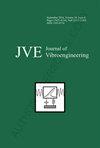Dynamics model and vibrational response analysis of helical gear-rotor-bearing transmission system
IF 0.9
Q4 ENGINEERING, MECHANICAL
引用次数: 0
Abstract
As a core component of wind turbines, wind power gear speed increasers often work in harsh environments, so it is necessary to study the vibration characteristics of gear transmission systems. Taking a wind turbine gearbox high-speed stage helical gear transmission system as the research object, the dynamics model of multi-degree-of-freedom helical gear-rotor-bearing transmission system is established by the lumped parameter method and solved by Runge-Kutta method, taking into account the tooth side clearance of the gear, transmission error, eccentricity and support force of the nonlinear bearing. The effects of input torque, transmission error and tooth side clearance on the vibration characteristic response of the helical gear train were analyzed. The relationship between the trend of amplitude change in each direction of the gear and the trend of change in the major frequency components was analyzed under the conditions of changing internal and external excitation. The results show that torsional vibration dominates in the system. As the input torque increases, the vibration amplitude of the driving and driven gears decreases, and the frequency amplitude decreases significantly at multiple locations. Gear transmission errors and changes in tooth side clearance have significant effects on gear vibration amplitudes, but are sensitive only to the meshing frequency. The trend of gear vibration amplitude caused by the change of external excitation of the gear set is synchronized with the trend of main frequency amplitude in the corresponding direction, while the change of vibration amplitude caused by internal excitation is consistent with the trend of mesh frequency amplitude in the corresponding direction. The results of this paper can pave a certain foundation for the design and fault diagnosis of wind power gearbox transmission system.斜齿轮转子轴承传动系统的动力学模型和振动响应分析
风电齿轮增速机作为风力发电机组的核心部件,经常工作在恶劣的环境中,因此有必要对齿轮传动系统的振动特性进行研究。以风力发电机齿轮箱高速级斜齿轮传动系统为研究对象,考虑齿轮齿侧间隙、传动误差、偏心率和非线性轴承的支撑力等因素,采用叠加参数法建立了多自由度斜齿轮-转子-轴承传动系统动力学模型,并采用 Runge-Kutta 法进行求解。分析了输入扭矩、传动误差和齿侧间隙对斜齿轮系振动特性响应的影响。在内外激振力变化的条件下,分析了齿轮各方向振幅变化趋势与主要频率成分变化趋势之间的关系。结果表明,扭转振动在系统中占主导地位。随着输入扭矩的增加,驱动齿轮和从动齿轮的振动振幅减小,多个位置的频率振幅明显减小。齿轮传动误差和齿侧间隙变化对齿轮振动振幅有显著影响,但只对啮合频率敏感。齿轮组外部激振力变化引起的齿轮振动振幅变化趋势与相应方向的主频振幅变化趋势同步,而内部激振力引起的振动振幅变化趋势与相应方向的啮合频率振幅变化趋势一致。本文的研究结果可为风电齿轮箱传动系统的设计和故障诊断奠定一定的基础。
本文章由计算机程序翻译,如有差异,请以英文原文为准。
求助全文
约1分钟内获得全文
求助全文
来源期刊

Journal of Vibroengineering
工程技术-工程:机械
CiteScore
1.70
自引率
0.00%
发文量
97
审稿时长
4.5 months
期刊介绍:
Journal of VIBROENGINEERING (JVE) ISSN 1392-8716 is a prestigious peer reviewed International Journal specializing in theoretical and practical aspects of Vibration Engineering. It is indexed in ESCI and other major databases. Published every 1.5 months (8 times yearly), the journal attracts attention from the International Engineering Community.
 求助内容:
求助内容: 应助结果提醒方式:
应助结果提醒方式:


